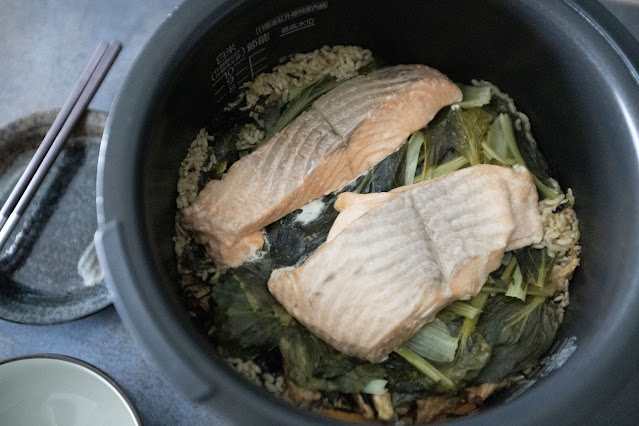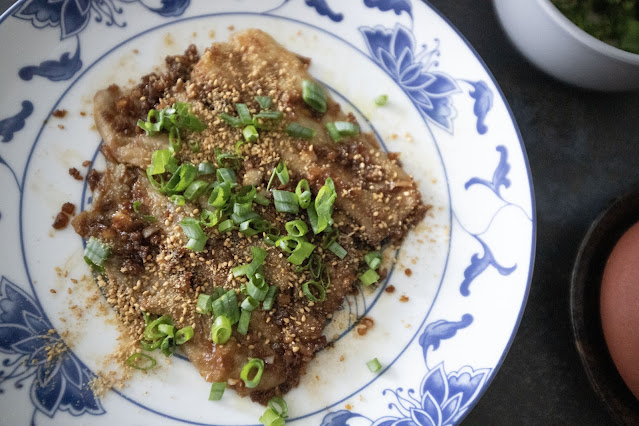So what's the difference between a tamagoyaki and a dashimaki tamago? Well, they are basically the same thing, just that the dashimaki tamago has more Japanese stock mixed in, so the texture is more pillowy or juicy so to speak.
I also think that Dashimaki tamago has a more mouthful name. Sometimes I would just explain this dish to others as dashi tamagoyaki, easier to be understood by westerners.
Dashimaki tamago だし巻き卵 -
Ingredients (about 3 to 4 pieces)?
- 4 eggs
- 1 teaspoon Japanese tsuyu
- 1 teaspoon mirin
- 1 teaspoon granulated sugar
- Some olive oil
Dashi/Japanese stock:
- 800ml drinkable water
- 1 medium piece kombu
- 10 grams katsuobushi (bonito flakes)
How?
Start with homemade Japanese stock/dashi. Use a medium pot and add in one medium piece of kombu. Use a scissor to cut into smaller pieces if the size doesn't fit. Pour in 800ml of drinkable water and turn on the heat.
Keep it just under boiling temperature. Once hot enough, turn-off the heat and let the kombu soak in there for an hour.
Later on bring the pot close to boiling temperature again. Once achieved, heat-off and add in 10 grams of bonita flakes. Soak for couple minutes.
Drain out the ingredients and keep the stock, that'll be our basic Japanese stock/dashi. Wait till cool enough before using it dashimaki tamago, at least cool enough so that it won't cook the egg when beating together.
For the egg mixture, crack 4 eggs to a bowl, I used a measuring cup instead. Also add in 4 tablespoons of dashi, 1 teaspoon of Japanese tsuyu, 1 teaspoon of mirin, and 1 teaspoon of granulated sugar. Beat till the sugar has been fully dissolved.
Use a tamagoyaki pan, also have a piece of paper towel folded into a square on the side. Drizzle just a little bit of olive oil to the pan and use that paper towel to evenly smear the oil throughout the area.
Switch to medium or medium low heat and wait till the pan warms up a little. Scoop some egg mixture to the pan and sear till the bottom almost set. Start rolling the egg from the outside then inward, to create almost a tube in the end.
Push that tube outward then use the paper towel again to smear some more oil to the empty area. Scoop some egg mixture to the empty area. Meanwhile lift up the egg tube a bit, so that the newly added egg mixture can flow underneath. It'll help binding the earlier egg tube with the new layer.
So again, wait till the bottom seems set then roll in the tube to form an even bigger tube. By now the shape should resemble a rectangular block more than a tube. Repeat the step one more time if you prefer a bigger sized dashimaki tamago in the end. Once all set, carefully move the dashimaki tamago to serving plate.
I'm using single serving tamagoyaki pan here, so the final portion is perfect for one serving. If you're using bigger tamagoyaki pan, most of the time you can slice the final egg block and turn into few individual servings.
You'll definitely have way more dashi left after making dashimaki tamago. You can use that as a stock for other dishes. What I did this time is that I used the leftover dashi to cook the rice, substituting the usual plain water. It'll give you a lightly flavored rice as a result, gentle yet won't overpower any other dishes served with the grains.
Other tamagoyaki recipes:








































